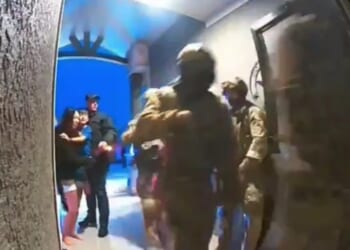Despite the Minuteman III’s continued effectiveness, the technology it relies on is quite old.
As tensions rise with Russia and China, the US Air Force is keen to demonstrate that they still have a global influence—and first rate deterrent capabilities. In a show of precision and range, the Air Force recently conducted a successful test of a non-armed Minuteman III intercontinental ballistic missile (ICBM). The launch, which is the second of the year, was initiated from Vandenberg Space Force Base in California—no doubt for the purpose of showing foreign observers that the US still has the missile portion of the nuclear triad intact and on guard.
Carrying an Mk21 high-fidelity reentry vehicle, the ICBM took off at 12:01 a.m. Pacific Time, accelerated to a speed in excess of 15,000 miles per hour, traveled over 4,200 miles, and struck a “designated target area near Kwajalein Atoll in the Marshall Islands.” With China making increased overtures throughout the Indo-Pacific region, the location of the ICBM test’s impact seems like a pointed message to Xi’s government.
“This ICBM test launch underscores the strength of the nation’s nuclear deterrent and the readiness of the ICBM leg of the triad,” General Thomas Bussiere, head of Air Force Global Strike Command, said in a statement.
All About the Minuteman III ICBM
The Minuteman III is the US Air Force’s primary land-based ICBM. Remarkably, the Minuteman III has a range of about 8,100 miles, making it capable of striking targets anywhere in the world, typically within 30 minutes of launch, from underground silos in the United States. The Minuteman can carry between one and three nuclear warheads atop independently targetable reentry vehicles (MIRVs) like the Mk21. Each MIRV can be outfitted with a variety of nuclear warheads of varying yields—but are commonly armed with the W87, with a typical yield of 475 kilotons. For reference, the Little Boy bomb dropped on Hiroshima had a 16 kiloton yield.
Capable of reaching Mach 23 (about 17,000 miles per hour!), the Minuteman III relies on an inertial guidance system, consisting of gyroscopes and accelerometers, to track its position as it moves through space. The missile’s guidance system is extremely precise, allowing the Minuteman to hit intended targets with accuracy, despite the range and speeds involved. Of course, with a warhead large enough to wipe out several cities, precise targeting data is more or less irrelevant in many cases.
Despite the Minuteman III’s continued effectiveness, the technology it relies on is quite old. The missile was first fielded in the 1970s. Upgrades relating to the guidance system, propulsion, and electronics have kept it in service, but the system is still considered legacy equipment—and will eventually be replaced.
Northrop Grumman is already working on the Minuteman III’s replacement: the Ground-Based Strategic Deterrent (GBSD) system. The estimated cost of the GBSD program is in excess of $100 billion. For that price tag, the Air Force is expected to receive a GBSD system with enhanced security against cyberattacks and electronic warfare. The GBSD will also feature cutting edge guidance systems, propulsion, and electronics, and like the Minuteman III, will be deployed in hardened silos throughout the continental United States. Hopefully, like the Minuteman III, the GBSD will never need to be launched outside of testing purposes.
About the Author: Harrison Kass
Harrison Kass is a defense and national security writer with over 1,000 total pieces on issues involving global affairs. An attorney, pilot, guitarist, and minor pro hockey player, Harrison joined the US Air Force as a Pilot Trainee but was medically discharged. Harrison holds a BA from Lake Forest College, a JD from the University of Oregon, and an MA from New York University. Harrison listens to Dokken.
Image: Wikimedia Commons.















